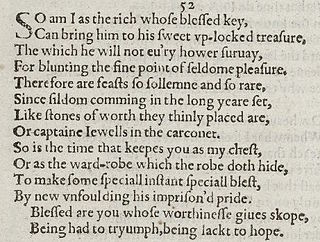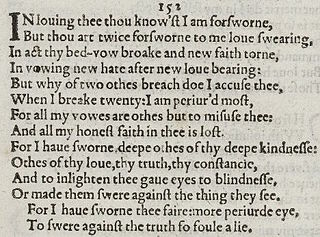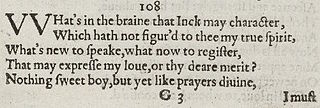| Sonnet 61 | |||||||
|---|---|---|---|---|---|---|---|
 Sonnet 61 in the 1609 Quarto | |||||||
| | |||||||
| |||||||
Sonnet 61 is one of 154 sonnets written by the English playwright and poet William Shakespeare. It is a member of the Fair Youth sequence, in which the poet expresses his love towards a young man.
| Sonnet 61 | |||||||
|---|---|---|---|---|---|---|---|
 Sonnet 61 in the 1609 Quarto | |||||||
| | |||||||
| |||||||
Sonnet 61 is one of 154 sonnets written by the English playwright and poet William Shakespeare. It is a member of the Fair Youth sequence, in which the poet expresses his love towards a young man.
Sonnet 61 is an English or Shakespearean sonnet, containing three quatrains followed by a final rhyming couplet. It follows the form's typical rhyme scheme, ABAB CDCD EFEF GG, and is composed in iambic pentameter, a type of poetic metre based on five pairs of metrically weak/strong syllabic positions. The seventh line exemplifies a regular iambic pentameter:
× / × / × / × / × / To find out shames and idle hours in me, (61.7)
The first and third lines have a final extrameterical syllable or feminine ending:
× / × / × / × / × /(×) Dost thou desire my slumbers should be broken, (61.3)
Although many rhymes in the sonnets are imperfect in today's pronunciation, they were almost all perfect (or at least potentially so) in Shakespeare's day. The a rhymes, "open" and "broken" constitute a rare instance of an imperfect rhyme in the Sonnets, [2] though the same rhyme occurs in Venus and Adonis lines 47 and 48. [3]

Sonnet 45 is one of 154 sonnets written by the English playwright and poet William Shakespeare. It is a member of the Fair Youth sequence, in which the poet expresses his love towards a young man. Sonnet 45 is continued from Sonnet 44.

Sonnet 49 is one of 154 sonnets written by the English playwright and poet William Shakespeare. It is a member of the Fair Youth sequence, in which the poet expresses his love towards a young man.

Sonnet 50 is one of 154 sonnets written by the English playwright and poet William Shakespeare. It is a member of the Fair Youth sequence, in which the poet expresses his love towards a young man. It is continued in Sonnet 51.

Sonnet 52 is one of 154 sonnets written by the English playwright and poet William Shakespeare. It is a member of the Fair Youth sequence, in which the poet expresses his love towards a young man.

Sonnet 70 is one of 154 sonnets written by the English playwright and poet William Shakespeare. It is a member of the Fair Youth sequence, in which the poet expresses his love towards a young man.
Sonnet 132 is one of 154 sonnets written by the English playwright and poet William Shakespeare.

Sonnet 152 is a sonnet by William Shakespeare. It is one of a collection of 154 sonnets, dealing with themes such as the passage of time, love, beauty and mortality, first published in a 1609.
Sonnet 149 is one of 154 sonnets written by the English playwright and poet William Shakespeare.

Sonnet 142 is one of 154 sonnets written by the English playwright and poet William Shakespeare.

Sonnet 139 is one of 154 sonnets written by the English playwright and poet William Shakespeare.

Sonnet 75 is one of 154 sonnets written by the English playwright and poet William Shakespeare. It is a member of the Fair Youth sequence, in which the poet expresses his love towards a young man.

Sonnet 119 is one of 154 sonnets written by the English playwright and poet William Shakespeare. It's a member of the Fair Youth sequence, in which the poet expresses his love towards a young man.

Sonnet 90 is one of 154 sonnets written by the English playwright and poet William Shakespeare. It is a member of the Fair Youth sequence, in which the poet expresses his love towards a young man.

Sonnet 95 is one of 154 sonnets written by the English playwright and poet William Shakespeare. It is a member of the Fair Youth sequence, in which the poet expresses his love towards a young man.

Sonnet 106 is one of 154 sonnets written by the English playwright and poet William Shakespeare. It is a member of the Fair Youth sequence, in which the poet expresses his love towards a young man.

Sonnet 108 is one of 154 sonnets written by the English playwright and poet William Shakespeare. It is a member of the Fair Youth sequence, in which the poet expresses his love towards a young man.

Sonnet 111 is one of 154 sonnets written by the English playwright and poet William Shakespeare. It is a member of the Fair Youth sequence, in which the poet expresses his love towards a young man.

Sonnet 114 is one of 154 sonnets written by the English playwright and poet William Shakespeare. It is a member of the Fair Youth sequence, in which the poet expresses his love towards a young man.
Sonnet 120 is one of 154 sonnets written by the English playwright and poet William Shakespeare. It's a member of the Fair Youth sequence, in which the poet expresses his love towards a young man.

Shakespeare's sonnet 117 was first published in 1609. It uses similar imagery to Sonnet 116 and expands on the challenge in the closing couplet. Using legally resonant metaphors, the poet defends himself against accusations of ingratitude and infidelity by saying that he was merely testing the constancy of those same things in his friend.